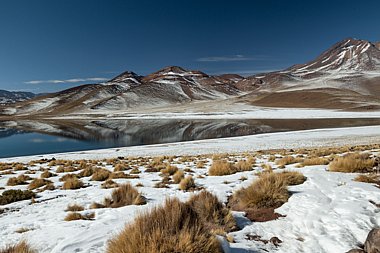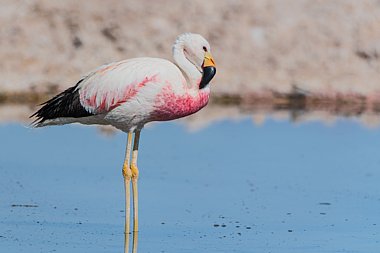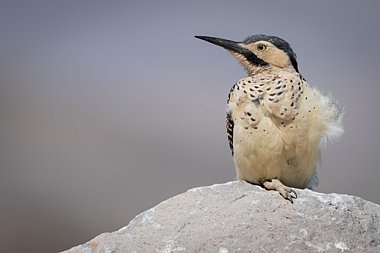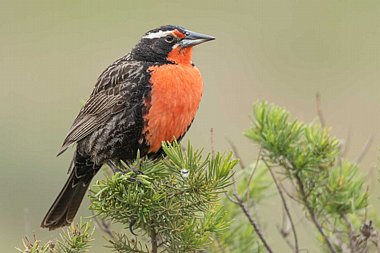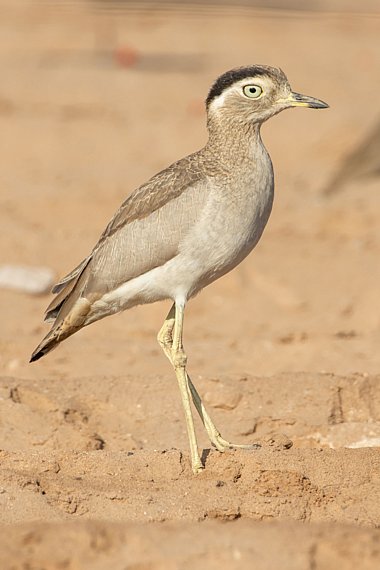NEW! Chile - The Atacama Desert
The spectacular birdlife of the Atacama and Altiplano regions of Northern Chile.
| Destination | |
|---|---|
| Focus | |
| 2026 Dates | |
| Duration | 16 Days |
| 2026 Price | £7695 pp £700 single supplement. Deposit £1500. Experienced Chilean guide Claudio F Vidal will lead for us on this tour. Claudio will be joined by another from the Heatherlea team with over 10 clients. pre-flight airport hotel and lounge are inc. |
| Max Group Size | 12 |
- Free Bird Guide
FREE copy of Birds of Chile with every room booked on this holiday.
- Tour Info Pack
- Enquire
Chile is fast becoming a popular birding destination, and on this new, carefully designed tour we combine the wonderful birdlife and scenery of the Santiago area with the spectacular Atacama and Altiplano desert regions to the north-east. With endemic species available both on land and at sea, and featuring unrivalled scenery and mountain landscapes, this is a memorable and exciting tour.
Our adventure begins in central Chile close to Santiago. Here we are perfectly placed to explore wonderful birding, from the heights of the Andes where we look for iconic South American species including Andean Condor and Diademed Sandpiper-Plover, to the Pacific west coast, where we target wetland specialists such as Stripe-backed Bittern and Black-headed Duck, and take an exciting pelagic voyage to see spectacular seabirds including endangered Humboldt Penguin and up to six species of albatross. With a surprising diversity, we should quickly build an impressive bird-list featuring a number of endemics including Chilean Tinamou, Chilean Mockingbird, Crag Chilia, Dusky-tailed Canastero and Dusky and White-throated Tapaculo, before moving inland to the dramatic interior of the Atacama Desert.
Covering 5% of national landmass, the Atacama is perhaps the world's driest desert, and certainly Chile’s largest. On average, its skies remain clear for over 300 days a year and in some areas no records of rainfall exist! The wildlife of these desert ecosystems is adapted to the hostile conditions of altitude, and we hope to encounter many of the 120 bird species regularly recorded in the Atacama, including Horned Coot, the most threatened of its genus in the world. Other birds include Puna Ibis, Puna Plover, Black-hooded and Red-backed Seirra Finch, Golden Spotted Ground Dove, Mountain Parakeet and Chilean, Andean and Puna Flamingos, plus mammals including Vicuña and Culpero Fox. Among sites we plan to visit are Chaxa, Miscanti and Meñiques Lagoons, the spectacular El Tatio Geysers and the highly photogenic Salar de Talar.
Relocating further north, we find ourselves on the fringes the Altiplano, an extensive area of wide plateau which spreads across four countries. Here in the southern part of this vast area we plan to visit birding hotspots including Lauca National Park (a UNESCO World Biosphere Reserve), Las Vicuñas Nature Reserve and the Azapa, Lluta, Camarones and Chaca Valleys near Arica. Targets include Diademed Sandpiper-Plover, Peruvian Thick-knee, Band-tailed, Rufous-bellied and Grey-breasted Seedsnipes, Sparkling Violetear, Andean Hillstar, Mourning and Ash-breasted Sierra Finches, Peruvian Sheartail, Oasis Hummingbird and Chile's smallest bird, tiny Chilean Woodstar. A second dedicated pelagic trip into the Humboldt Current gives us chances to see Peruvian Diving Petrel, Elliot’s and Markham’s Storm Petrels plus endangered Peruvian Tern and stunning Inca Tern! This is a wonderful new tour boasting multiple birdlife and scenic splendour.Special thanks to our friends Jorge Valenzuela and Enrique Coure for images on this page.
Enjoy your complimentary pre-flight overnight hotel before your holiday begins. Full details from our office! Read more about our Pre-flight Service here!
Day 1: Tue 24 November 2026 - Flight from UK to Chile
After relaxing in our complimentary VIP Airport Lounge, we fly London to Santiago overnight.
Day 2: Wed 25 November - Farellones and Valle Nevado
Our birding adventure in Chile begins today, and after recovering from the flight and check into our hotel, we meet our guide Claudio, and head out birding for the afternoon. We won’t have to travel far before finding ourselves in the spectacular setting of Farellones, where several Andean specialities may be seen, including White-sided Hillstar, Rufous-banded and Creamy-rumped Miner, Cinereous, Black-fronted, White-browed and Rufous-naped Ground-tyrant, Greater Yellow-Finch, Grey-hooded and Band-tailed Sierra-Finch. We also look for endemic Chilean Tinamou and Chilean Mockingbird and may see Mountain Caracara, Red-backed Hawk and Aplomado Falcon while scanning the skies for raptors. Overnight Santiago for two nights.
Day 3: Thur 26 November - El Yeso Valley
A full day to explore part of the Andes, where in the foothills surrounding El Yeso reservoir we hope to see our first Andean Condors. The largest and without doubt one of the most iconic birds of prey in the world, to see them gliding on mid-morning thermals within their natural surroundings will be etched into our birding memories forever! Black-chested Buzzard-Eagle are likely and we hope to be rewarded with sightings of endemic Crag Chilia and flocks of Mountain Parakeet too. Other Andean specialities which may be encountered today include Black-winged Ground Dove, Grey-flanked Cinclodes, Black-billed Shrike-Tyrant and Yellow-rumped Siskin. Stunning Diademed Sandpiper-Plover is one of the top targets of our tour, and though we plan to visit locations for them in the North, scanning the grasslands and streams here may produce our first sighting. In the afternoon we visit nearby Baños Morales, another valley offering good birding with further chances of seeing local specialities amid wonderful mountain views.
Day 4: Fri 27 November - Maipo Estuary, Laguna El Peral Nature Reserve
The Coastal Range separates Chile’s central valley from the Pacific coast, and today we drive west to explore the productive Maipo river mouth and surrounding coastal wetlands. At El Peral Reserve our targets include cryptic-colored Stripe-backed Bittern, the brood-parasitic Black-headed Duck and striking Many-colored Rush Tyrant to name but some. Commoner wetland species in this area include Silvery, White-tufted and Pied-billed Grebe, Black-crowned Night Heron, Black-necked Swan, Yellow-billed Pintail, American Oystercatcher, Kelp, Grey and Brown-hooded Gull and we may also find scarce Ticking Doradito in the scrub. Overnight Viña del Mar for two nights.
Day 5: Sat 28 November – Valparaiso Pelagic – Albatross and Humboldt Penguins
Today we explore one of the world’s finest pelagic birding destinations with an unforgettable boat trip out into the seas of the Humboldt Current. The cold and productive waters off western Chile are fantastic for tubenoses with many species of albatross possible including Black-browed, Salvin’s, Buller’s, Chatham, Wandering (Antipodean) and both Northern and Southern Royal. Among other possible seabirds are Southern and Northern Giant Petrel, Pintado, Masatierra, White-chinned and Westland Petrel, Pink-footed, Buller’s and Sooty Shearwater, Wilson’s Storm Petrel, Peruvian Diving Petrel, Grey (Red) Phalarope, Sabine’s Gull and Chilean Skua. We plan to visit a protected breeding colony of endangered Humboldt Penguin north of Valparaiso and may also see Marine Otter here too. Cetaceans are possibe, and though harder to predict can include Dusky Dolphin and Southern Right Whale Dolphin. Before ending the day, we may visit a nearby marsh to see wetland species. A variety of waterfowl including Red Shoveler, Speckled Teal and Chiloe Wigeon may be seen, plus Red-gartered, White-winged and Red-fronted Coot, Spot-flanked Gallinule and Plumbeous Rail, the latter often surprisingly easy to see as it often walks in the open.
Day 6: Sun 29 November - La Campana National Park and fly to the Atacama Desert
We begin the day with a morning visit to La Campana National Park, an area close enough to the ocean to sustain broad-leafed forests and a xeric shrub community named ‘the matorral’ (Chile’s equivalent to California’s chaparral). The habitat supports several Chilean endemics and among our targets are Dusky-tailed Canastero, Moustached Turca, Dusky and White-throated Tapaculo. La Campana can also be a good site for Giant Hummingbird and also possible are Striped Woodpecker, Austral Pygmy Owl and Chilean Pigeon. While birding, our attention will inevitably be drawn to Mount La Campana (The Bell) which dominates the skyline offering a superb vista. After a rewarding morning, we drive to Santiago airport for our afternoon flight east to Calama. As we come to land, we see the unique Atacama Desert environment for the first time, board our vehicle and drive to the vibrant oasis village of San Pedro de Atacama where we stay for three nights.
Day 7: Mon 30 November - Chaxa, Miscanti and Meñiques Lagoons and Salar de Talar
Today we begin our exploration of the driest desert in the world, visiting a series of high Andean lakes which at an altitude of around 4000m above sea level offer a striking and unique birding environment! We enjoy birding as we pass through the agricultural villages of Socaire and Tocanao, the latter characterized by its stone houses and beautiful orchards. Gaining height and continuing to Lagunas Miscanti and Miñiques, we aim to see an array of specialist birds from well-defined trails within the protected reserve. Horned Coot is the largest and most threatened coot in the world and one of the few breeding populations is found here. Also possible are Puna Flamingo, Pena Tinamou, Puna Plover, Rufous-bellied Seepsnipe, Black-hooded and Red-backed Seirra Finch, Golden Spotted Ground Dove, Straight-billed Earthcreeper and perhaps Mountain Parakeet. Herds of Vicuña gather around the lakes, while also in the area are Culpero Fox and Vizcacha. Later, we continue south to Salar de Talar for one of the most splendid vistas of the day. Offering wonderful photo opportunities of the turquoise-colored lake and the soft textures of the surrounding mountains and volcanos, this will be a spectacular place to end a day in the desert.
Day 8: Tue 1 December - El Tatio Geysers and Tamarugo Forest
An early start for a visit to the impressive El Tatio Geysers, the third largest geyser field in the world, and at an altitude of 4200m above sea level are among the highest. On a dawn visit we take in this bizarre landscape as the sun rises, observing columns of steam, cones of crystallized silica and other salts, plus ponds of boiling pastel-colored mud. Surprisingly, some plants and animals have adapted to live in these extreme environments at the very limit of where life is possible. Later we descend to the Putana River for Giant and Andean Coot, Puna and Yellow-billed Teal plus a range of other birdlife. We also have time to explore the flora, adapted to the extreme altitude and harsh conditions and one of the most conspicuous plants is the tall, columnar Atacama Cactus which grows in the gorges and hillsides along the Puritama river. In the afternoon we devote time to check the Tamarugo and Chañar woodlands near San Pedro, to search in particular for Tamarugo Conebill, a speciality of northern Chile.
Day 9: Wed 2 December - Transfer Calama – Santiago - Arica
A travel day, returning to Calama for a connecting flight to Arica via Santiago. Depending on our time of arrival, we may have time for some coastal birding close to our hotel. Overnight in Arica
Day 10: Thur 3 December - Putre Highlands
Leaving the coast and heading inland towards the imposing slopes of the Andes, we search first around the lowland cultivated valleys for Peruvian Thick-knee, Andean Swift and Grayish Miner. Next we drive into the highlands to reach the hyper-arid desert and mountain village of Putre, a picturesque Andean settlement located at 3400m above sea level, and our base for the next two nights. The pre-puna, semi-arid bushy slopes are rich in birdlife, with Sparkling Violetear, Andean Hillstar, Creamy-breasted and Canyon Canasteros, Golden-billed Saltator, Blue-and-yellow Tanager, Hooded and Thick-billed Siskin among the many exciting species. The gardens, cultivated terraces, eucalyptus groves and rocky walls surrounding Putre provide the perfect habitat for Aplomado Falcon, Mountain Parakeet, Bare-faced Ground Dove, Spot-winged Pigeon, White-throated, Plain-breasted Earthcreeper, White-winged Cinclodes, Black-throated Flowerpiercer, Chiguanco Thrush, White-browed Chat-Tyrant, Band-tailed Seedeater and Black-hooded, Mourning and Ash-breasted Sierra Finches. We can certainly expect a great day’s birding!
Day 11: Fri 4 December - Lauca National Park
The Altiplano, Puna or High Andean Plateau above 4000m is truly a mecca for wildlife and we have the whole day to discover its many secrets amid stunning landscapes. Established to protect the highest lake in the world (and a World Biosphere Reserve), Lauca National Park supports a great density of Andean fauna. The high-altitude bogs, locally known as ‘bofedales’, hold a remarkable number of species (all endemic to this eco-region), and specialities include exquisite Diademed Sandpiper-Plover, Chilean, Andean and Puna Flamingo, Andean Avocet, Giant and Andean Coot, Puna Ibis, Andean Goose, Puna Teal, Andean Avocet, Andean Lapwing, Puna Plover, Rufous-bellied and Grey-breasted Seedsnipes. The surrounding barren plains are good habitat for both Puna Rhea and Puna Tinamou - an impressive cast indeed! At 4500m, the Lake Chungara area will be the highest spot of our entire trip, and surrounded by imposing volcanoes, boasts one of the most beautiful views in Northern Chile. Among new species we might find here are Andean Flicker, Cordilleran Canastero, Puna and White-fronted Ground Tyrants, Andean Negrito, White-winged Diuca Finch and Black Siskin.
Day 12: Sat 5 December - Azapa and Lluta valleys
In the morning we drive back to Arica, planning to investigate the bird-rich valleys of Azapa and Chaca, the haunt of specialities such as Croaking Ground Dove, Chilean Woodstar, Peruvian Sheartail, Oasis Hummingbird, Tamarugo and Cinereous Conebill, Bran-colored and Vermillion Flycatcher, Peruvian Meadowlark and the odd-looking Slender-billed Finch. The productive estuary on the Lluta River should give us variety and boost our checklists, with ample opportunities to study coots, egrets, shorebirds, terns and gulls which gather to roost in large numbers. Overnight Arica for two nights
Day 13: Sun 6 December - Pelagic trip off Arica, Chaca and Camarones valleys
Early morning, we take a boat trip off Arica to continue our search for the endemic seabirds which favour the Humboldt Current. Our prized target will be Peruvian Diving Petrel and we should also find Elliot’s and Markham’s Storm Petrel and if lucky, scarce Wedge-rumped and Hornby’s Storm Petrel too. The delightful Inca Tern should be seen around the harbour, often alongside South American Tern while endangered and local Peruvian Tern is another potential sighting. Along the rocky coast south of Arica we expect a great array of seabirds including Peruvian Pelican, Peruvian Booby, Guanay and Red-legged Cormorant, Little Blue Heron, Elegant Tern, Belcher’s, Franklin’s and Grey Gull. Possible waders on the coast include Willet, (Hudsonian) Whimbrel and Surfbird. Extending our journey southwards to Camarones Gorge we hope to encounter Pied-crested Tit-Tyrant and Yellowish Pipit too.
Day 14: Mon 7 December - Flight to Santiago
We leave Arica and fly back to Santiago, perhaps with some time to relax or explore the city in the afternoon if flight times allow. Overnight Santiago for one night.
Day 15: Tue 8 December - Return to the UK
Transfer to Santiago Airport for the (usually) early-afternoon flight back to the UK overnight, arriving in the morning of Day 16 Wed 9 December 2026.
Please note: all itineraries are given as a guide only. Actual holiday content may vary according to the judgement of your guide, and elements beyond our control (eg weather).
What's included in your holiday price:
- Scheduled return flights between London and Santiago de Chile. All internal flights (three in total). Airport taxes and transfers.
- Ground transportation as outlined including all transportation in Chile in a modern and spacious air-conditioned vehicle.
- Two dedicated pelagic trips as described in the itinerary.
- Accommodation and all meals, including breakfast, lunch and dinner.
- The services of your leaders.
- Entrance fees to parks and reserves, and tips to hotels and restaurants.
- Departure taxes.
- The Heatherlea Pre-Flight Service offers everything you need at the airport, including hotels, car parking, airport lounges, regional flights, and upgrades. Let Heatherlea take the strain! Pre-flight airport hotel and lounge included free of charge subject to terms and conditions. Read more....
FREE! Field Guide to the Birds of Chile, Including the Antarctic Peninsula, the Falkland Islands and South Georgia, by A Jaramillo, P Burke, D Beadle published by Helm is included in your holiday price.

What's not included in your holiday price:
- personal insurance, drinks and other personal expenses, visa costs where necessary, optional tips to the driver and local guide, and any other costs not specified as 'included'.
More holiday information:
Accommodation is en-suite in comfortable hotels. Some important detail including final hotels can only be confirmed nearer the time, though those hotels quoted reflect the standard provided.
Food Breakfast is usually served as a buffet, with a wide choice. Lunch and dinner usually feature traditional local dishes. For convenience, we will often take packed lunches when in the field. Meals include water/soft drink, and snacks and beverages during outings. Vegetarian and other diets are welcome. A large water dispenser will be available on our bus, please bring your own water bottle so you can refill as required.
Walking is generally light/moderate. There is some uphill track and road walking, and an average level of fitness is required. We suggest to bring comfortable walking boots.
Weather will be mixed. Santiago and the north experience weather similar to the Mediterranean with temperatures to 25ºC during the day. However, the mornings can be slightly chilly usually around 5-10ºC at dawn and we anticipate cooler temperatures during our pelagic trips and morning outings in the Andes. Daytime temperatures in the Atacama Desert are usually higher, approaching 30ºC but significantly cooler at night, down as low as 5º.
Insects There are no major issues with biting insects. Bring a insect repellent just in case.
Group size is restricted to 12 clients maximum.
Flights are by scheduled airline, from London. Should you wish to extend your stay in Chile, either before or after your holiday, we will be happy to arrange this for you. All arrangements will be tailored to your requirements, please contact us.
Altitude considerations Trip elevations range between sea level and 4,000m within the Atacama Desert.
Your Leaders:
CLAUDIO F. VIDAL
Claudio has been exploring and birding since the age of 12 and currently leads birding/nature tours and photo safaris throughout Patagonia, Chile and South America. He has a particular interest in the seabirds and marine mammals occurring in the Humboldt Current, Patagonia and Antarctica, and is vastly experienced in their identification. Botany is also one of his greatest passions, leading him to devote to the photographic documentation of wildflowers of desert and Mediterranean regions of the world, of which he possesses a vast archive. Claudio is now finishing the writing of a Field Guide to the Birds of Chile together with a team of accomplished field ornithologists, and is co-author of more than 20 books, including the acclaimed Birds of Patagonia, Tierra del Fuego and Antarctic Peninsula. He is actively involved in several ecotourism projects in Chile which he supports from his home in Punta Arenas.

Claudio
Claudio will be joined by a member of the Heatherlea team with 10 or more clients.
Other birding and wildlife holidays in Chile
Why choose Heatherlea for your birding and wildlife holiday in the Americas?
Our overseas holidays are planned with care to offer great birding and wildlife, led by capable Leaders who really look after you. Every holiday is run the 'Heatherlea Way', and we hope our Overseas Adventures remind you of the quality and care so many of you enjoy in Scotland. That means rewarding and exciting days in the field, and good quality accommodation and meals, with a real flavour of the country we are visiting. Heatherlea always seek to include the personal touches that make all the difference.
Heatherlea holidays are not ‘dawn to dusk’ expeditions. Our less-intensive approach is ideal for those who want to relax whilst experiencing the best wildlife watching, and wherever possible we organise early or late activity on an optional basis. We also take sensible breaks when in very hot places and regular comfort breaks on every holiday whenever possible. All itineraries are planned carefully around the best wildlife opportunities, and you won’t miss out on memorable wildlife, whilst enjoying relaxed, informal days that are great fun.
The really important part of any wildlife holiday is the experience for you, our valued customer. Heatherlea invest in many things to offer you the best possible service;
- We have been organising birding and wildlife holidays for over 30 seasons, and have a highly experienced and capable office team. We also offer a telephone and email service outside normal office hours.
- Heatherlea overseas holidays have a maximum of 12 clients per trip, putting the emphasis on personal service, and helping you get the best possible experience.
- Our holidays often include things which others might invite you to pay yourself, for instance Departure Taxes and tips to hotels.
- All elements of our holidays are sold under our own licence, ATOL 6113. Under ‘Flight-Plus’ legislation it is a legal requirement of any tour operator to hold an ATOL licence for the supply of any overseas holiday where a flight is involved, if that holiday includes either overseas accommodation and/or car hire. It can be a criminal offence for an operator to book flights as part of a package without an ATOL licence. Heatherlea also hold full Tour Operator Insurance for your added protection.
- Heatherlea is your complete wildlife holiday provider. Our ‘Back Office’ team can organise all your pre-flight and other travel needs. Our specialists will help you book the right services, at the best price. Book holiday extensions through us, and your ATOL protection is extended further. We don’t charge extra for this service.
- Heatherlea is a limited company, registered in Scotland, and registered to pay VAT (applies to all holidays within the European Union).
Trip Reports
Coming Soon
- Free Bird Guide
FREE copy of Birds of Chile with every room booked on this holiday.
- Tour Info Pack
- Enquire


